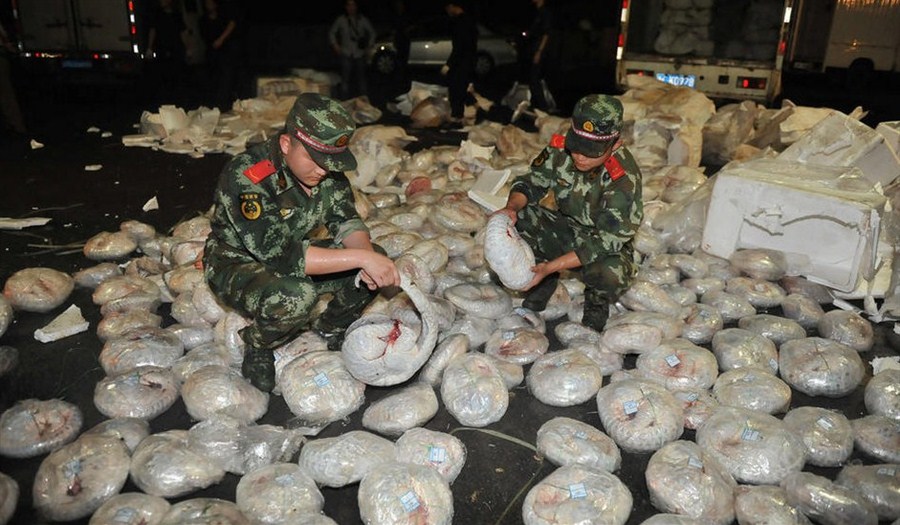Throwback Thursday is when we trawl through the That's archives for a work of dazzling genius written at some point in our past. We then republish it. On a Thursday.
By Jane Kent
By the time animals or wildlife products are placed in the hands of the consumer, they have made long journeys through forests, rivers, over land and sea before delivery to dealers and clandestine markets. Wildlife trafficking operates through a vast web of players: poachers, human ‘mules,’ retailers, exporters, local villages and corrupt officials – all connected globally through organized crime networks.
International illegal wildlife trade was worth an estimated USD19.1 billion annually in 2014, with dozens of agencies and experts continually identifying the Middle Kingdom as the key destination, according to the 2013 report by the International Fund for Animal Welfare (IFAW). And demand is growing.
“Ten years ago, less than 10 percent of confiscations in the Global Confiscations Database were in China. Now, China accounts for 80 to 90 percent,” says Dr. Li Zhang, an associate professor of field biology at Beijing Normal University, who has studied wildlife consumption for nearly 20 years.
The dramatic economic growth in the last few decades and the ease of Internet sales has manifested unprecedented demand. “Many Chinese can now afford luxury products – some of them being wildlife products, illegal and legal,” Dr. Li explains.
Part of the difficulty of monitoring and enforcing this market stems from its incredibly diverse list of uses and motives. As demand increases, it is no surprise that parts of China’s borders are now known internationally as “wildlife hotspots,” especially those shared with Laos and Myanmar.
“They are so long, and with such complicated topography and social-economic situations, it is impossible to control the border lines as compared to airports and seaports. So, the land borders easily become the main trade route for trafficking wildlife,” explains Zhang Sheng, Campaign Program Manager at Traffic China.
“Guangxi, Guangdong and Yunnan are major destinations of wildlife from southeast Asia smuggled into Guangxi and Yunnan at key border ports, based on our research,” says Dr. Li. A common route begins at the Myanmar border in Ruili, Yunnan, snakes through Guangxi and finishes in Guangdong.
Another begins in wildlife-rich Qinghai Province and moves down through Sichuan and Guangxi, ultimately ending again in Guangdong. Ultimately, the southern province is where the highest prices are fetched – Dr. Li reports that 85 percent of wildlife smuggled through Guanxi from various routes will end up in Guangdong.
“Frankly speaking, China has invested a lot of enforcement along the border with these countries and it is not easy to observe open sale of illegal wildlife products in the markets on China side,” explains Zhang.
“But all these neighboring countries deal with a much weaker law enforcement situation [lack of staff, equipment, and knowledge] and even corruption.” Both Traffic and Dr. Zhang’s work involve improving capacity for enforcement by training customs officers on species identification, smuggling methods and conducting inspections.
These threatened species, many still tenuously alive, don’t have far to float—just ten meters across the river and into China.
However, many smugglers never even have to sweat it through customs. The long shared borders mean trade can occur without even risking interactions with enforcement agencies. In a 2013 paper for Wildlife Conservation Society, Scott Roberton did hundreds of hours of surveys over three months, focusing on the trade of all products along the Ka Long River in Mong Cai City, Vietnam.
“The cargo that gets unloaded into rickety boats on the Vietnam side of the Ka Long River includes wild tigers, elephant tusks, pangolins, rhino horns and wild turtles,” reports Roberton. “These threatened species, many still tenuously alive, don’t have far to float – just ten meters across the river and into China.” His analysis found that “over 90 percent of all products (both legal and illegal) traded in Mong Cai between Vietnam and China are passing through illegal crossings.”
With low-risk routes like Mong Cai, high profits and weak penalties, it is no wonder wildlife smuggling is an attractive endeavor to people from all walks of life. As IFAW’s President Azzedine Downes notes, profits “have surged to levels once reserved for legally traded precious metals.” Revenue in illegal wildlife trade now matches profits from drugs and arms trade – and many are positing that wildlife trade should be acknowledged as an increasing threat to global security.
The decimation of species is the obvious concern, but the connection to security is not as readily apparent. Smuggling animals has become a more “structured and well organized crime in recent years,” says Zhang. Many links are required from animal source to consumer, since “it is usually impossible for one single person to complete all these processes. International organized crime groups have been involved in this crime to make money, even terrorist groups to support their terrorism activities.”

A 2014 bust in Guangdong uncovered more than 1,000
frozen pangolins en route to dinner tables.
Governments and agencies around the world are seeing the effects of global crime syndicates lubricating the mechanisms of smuggling at all levels. Militias and warlords in Africa arm poachers and use profits from selling illegal ivory to fund terrorist acts. The entanglement easily overlaps with other illegal trade operated by organized crime. “Wildlife is being increasingly used to import drugs,” reports INTERPOL. With the same routes and methods being used, animal trafficking can obfuscate drug crimes and weak and inconsistent penalties mean lower risks. Geographically it’s not difficult to see how the two crimes became intertwined. Heroin is processed in Southeast Asia’s “Golden Triangle,” and cocaine in the Amazon – both areas rich with rare and exotic species.
The IFAW argues that addressing wildlife issues will improve economic security in unstable, developing countries and even public health. Smuggling cases are believed to be ground zero for some new health threats in recent years – a civet cat being smuggled in China has been identified as the likely animal-human transmission point which birthed SARS in Guangzhou.
China’s appetite for animals and wildlife products is not an isolated threat to conservation, but one part of the shadowy black market trading that crosses real and invisible borders worldwide. In order to begin to shrink the role wildlife trade plays in organized crimes, the IFAW urges it be elevated to the same level of crimes such as drug and human trafficking in the hopes that this gives rise to a global coordinating prevention network.
The Cobra II bust in February 2014 demonstrated the need for an international approach. The operation was led by China and had participation from 28 countries. The global crackdown netted more than 3 tonnes of ivory, 1000 hides, 36 rhino horns and many other wildlife products.
While enforcement is strengthening around the world, “no single approach can decrease wildlife trafficking,” says Zhang. As long as demand exists, suppliers will try to meet it. As the Chinese fuel consumption, “increasing public awareness about this issue and changing consumer behavior” is going to be a crucial step for the Middle Kingdom.
This article first appeared in the June 2014 issue of That's PRD and That's Shanghai. To see more Throwback Thursday posts, click here.






















0 User Comments